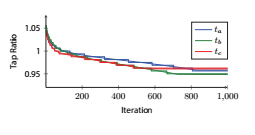Optimal Tap Settings for Voltage Regulation Transformers in Distribution Networks
Brett Robbins with adviser A. Domínguez-García
Tap-changing under-load (TCUL) transformers are commonly used for network voltage regulation in power distribution systems. Traditionally, automatic voltage regulators (AVRs) are equipped to control TCUL tap settings based on local voltage measurements. While this approach is effective for local voltage regulation, it is not optimal for meeting overall system operational objectives, e.g., power losses, global voltage regulation, etc. We develop an optimal transformer tap setting framework by utilizing recent advances in point-to-point communications among various control and monitoring devices within distribution networks. The proposed decision-making problem is related to the optimal power flow problem (OPF) that arises in transmission system operations.
Our work tailors the OPF formulation for distribution networks to include the tap settings of distribution transformers as decision variables; this is crucial to enable optimal voltage regulation in distribution networks. We cast the problem as a rank-constrained semi-definite program (SDP) that can be solved using convex solvers by dropping the only non-convex rank-1 constraint. To tackle a higher computational complexity of solving an SDP problem as compared to traditional iterative OPF methods, we utilize the alternating-direction method of multipliers (ADMM) method to create a distributed solver. ADMM has been widely used as a simple yet powerful technique for solving distributed convex optimization problems.The ability to perform the optimization tasks in parallel can dramatically reduce computation time and complexity, especially for large-scale systems. We performed a simulation to demonstrate the distributed solver on a 15-bus, three-phase unbalanced distribution network. Figure 26 shows the evolution of the tap ratios and Fig. 27 shows the output of the objective functions.
This material is based upon work supported by ABB under project “Distributed and Resilient Voltage Control of Distributed Energy Resources in the Smart Grid” (University of Illinois contract UIeRA 2013-2955-00-00).

